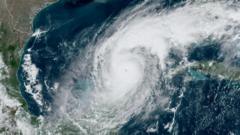The Atlantic hurricane season for 2025 is projected to be more turbulent than usual, according to NOAA forecasts, which indicate a likelihood of six to ten hurricanes forming between June and November. This uptick is attributed to warmer sea temperatures linked to climate change and favorable atmospheric conditions. Experts, however, express serious concerns that recent staffing reductions at government research agencies may hinder the capacity to effectively track and predict these severe storms.
This year's forecast suggests a total of 13 to 19 named tropical storms, with 6 to 10 expected to develop into hurricanes, including 3 to 5 major hurricanes, defined as those reaching Category 3 or above with wind speeds exceeding 111 mph. While this prediction does not exceed the previous year's record of 18 tropical storms and 11 hurricanes, it exceeds the long-term averages of 14 named storms and 7 hurricanes, with 3 major ones per season.
Two primary factors contribute to the increased hurricane likelihood. Firstly, sea surface temperatures are currently above average across most of the tropical Atlantic, enhancing conditions for hurricane development. Secondly, the natural weather phenomenon known as El Niño, which typically stifles hurricane formation, is not predicted to emerge this year. Instead, neutral or weak La Niña conditions, which generally facilitate hurricane development, are expected.
Despite an active prediction, local atmospheric dynamics, dust levels, and various other conditions crucial for hurricane formation remain unpredictable months in advance. Phil Klotzbach, a research scientist at Colorado State University, emphasizes that precise forecasting requires additional data and resources.
However, the staffing cuts initiated by the Trump administration during his second term have raised alarms within the scientific community. Hundreds of NOAA employees have been let go to streamline government expenditure, resulting in a significant understaffing crisis at the National Weather Service, hampering its ability to provide timely forecasts as the hurricane season approaches. Critical operational challenges persist, with reports of a shortage of experienced staff affecting essential forecasting capabilities.
Experts warn that the lack of adequate personnel could lead not only to burnout among the remaining staff but also degrade the quality of hurricane tracking efforts, which could endanger lives during severe weather events. Notably, vital positions within offices located in hurricane-prone areas like Houston remain unfilled, leaving critical functionalities compromised.
As the department struggles with staffing shortages, more than 150 positions are reportedly waiting to be filled, despite a hiring freeze. The implications extend beyond the United States, potentially disrupting global weather forecasting, as accurate models heavily rely on data from various international sources.
Dr. Daniel Swain, a climate scientist, encapsulates the danger, stating that the ongoing budget cuts could merely be "the tip of the iceberg," suggesting future risks to safety if not addressed immediately. Meanwhile, NOAA officials maintain that they employ top-tier scientists to continue advancements in forecasting, assuring the public of their dedication to safety measures. The 2025 hurricane season will test both the commitment of these agencies and the resilience of their forecasting capabilities as extreme weather events loom on the horizon.
This year's forecast suggests a total of 13 to 19 named tropical storms, with 6 to 10 expected to develop into hurricanes, including 3 to 5 major hurricanes, defined as those reaching Category 3 or above with wind speeds exceeding 111 mph. While this prediction does not exceed the previous year's record of 18 tropical storms and 11 hurricanes, it exceeds the long-term averages of 14 named storms and 7 hurricanes, with 3 major ones per season.
Two primary factors contribute to the increased hurricane likelihood. Firstly, sea surface temperatures are currently above average across most of the tropical Atlantic, enhancing conditions for hurricane development. Secondly, the natural weather phenomenon known as El Niño, which typically stifles hurricane formation, is not predicted to emerge this year. Instead, neutral or weak La Niña conditions, which generally facilitate hurricane development, are expected.
Despite an active prediction, local atmospheric dynamics, dust levels, and various other conditions crucial for hurricane formation remain unpredictable months in advance. Phil Klotzbach, a research scientist at Colorado State University, emphasizes that precise forecasting requires additional data and resources.
However, the staffing cuts initiated by the Trump administration during his second term have raised alarms within the scientific community. Hundreds of NOAA employees have been let go to streamline government expenditure, resulting in a significant understaffing crisis at the National Weather Service, hampering its ability to provide timely forecasts as the hurricane season approaches. Critical operational challenges persist, with reports of a shortage of experienced staff affecting essential forecasting capabilities.
Experts warn that the lack of adequate personnel could lead not only to burnout among the remaining staff but also degrade the quality of hurricane tracking efforts, which could endanger lives during severe weather events. Notably, vital positions within offices located in hurricane-prone areas like Houston remain unfilled, leaving critical functionalities compromised.
As the department struggles with staffing shortages, more than 150 positions are reportedly waiting to be filled, despite a hiring freeze. The implications extend beyond the United States, potentially disrupting global weather forecasting, as accurate models heavily rely on data from various international sources.
Dr. Daniel Swain, a climate scientist, encapsulates the danger, stating that the ongoing budget cuts could merely be "the tip of the iceberg," suggesting future risks to safety if not addressed immediately. Meanwhile, NOAA officials maintain that they employ top-tier scientists to continue advancements in forecasting, assuring the public of their dedication to safety measures. The 2025 hurricane season will test both the commitment of these agencies and the resilience of their forecasting capabilities as extreme weather events loom on the horizon.



















